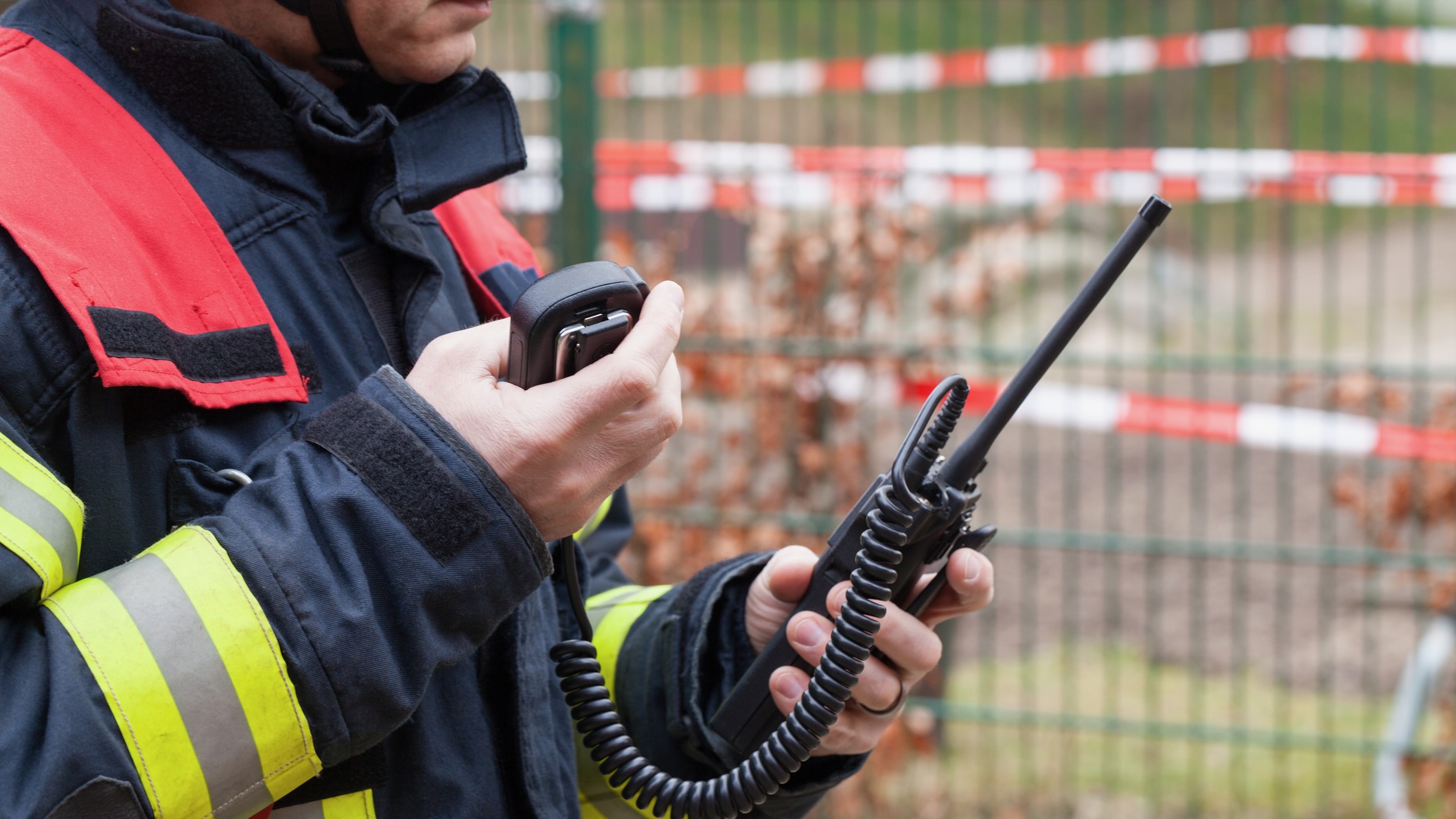A journalist’s journey from analog roots in radio to the horizons of AI

Mike Janssen, using DALL-E 3
With the majestic Sandia Mountains as my backdrop, I embarked on a transformative journey in the early 1990s as a work-study reporter at KUNM in Albuquerque, N.M., a role that would profoundly shape my understanding of storytelling and the world.
Those days were more than just about learning the ropes of reporting; they were about balancing life as a single mother and a student at the University of New Mexico, with my mother, Laleh Bakhtiar, then a Ph.D. candidate, by my side. Together with my brother Karim Ardalan, we raised my children, Saied and Samira, nurturing our minds and growing as a family in the Land of Enchantment.
Adapting to the digital age at NPR

By 1993, I transitioned to NPR News, a significant shift in my career that began when journalist Doug Mitchell noticed my application for a CPB multicultural producer grant. This move occurred around the dawn of the internet revolution. At NPR, working alongside the late MJ Bear, I vividly remember the thrill and challenge of adapting our weekend cooking features for the emerging digital platform that would become NPR.org. It was a pioneering time, a period of exploration and innovation, where we learned to weave the intimacy of radio storytelling into the vast, unexplored digital realm.
This era represented a significant transition for NPR, where traditional radio broadcasting began to intertwine with digital platforms, opening up new avenues for content delivery and audience engagement. Fast forward to the present, and I find myself confronting a new frontier with Artificial Intelligence (AI) and content creation. The task now is to ethically and effectively integrate AI into our journalistic practices.
The new AI frontier
My early experiences at KUNM, learning the value of community-centric storytelling, combined with my time at NPR during the internet’s infancy have shaped my approach to AI in journalism. Like how we embraced the internet to broaden our reach, AI offers significant potential to enhance our journalistic practices. It enables us to focus on the core elements of storytelling — the interviews and investigations, cultural and community reporting that form the essence of public media.
Our responsibility is to integrate AI with intention and care. This means ensuring AI tools honor the diverse voices of our audience, maintaining transparency in our reporting, and vigilantly checking for biases. Our approach to integrating AI into journalism must be inclusive. It’s crucial to engage with our communities, inviting their input and ensuring AI-generated content is human-guided so that the content resonates and serves audiences effectively.
Integrating AI ethically and effectively
As the digital landscape has evolved since those early days at NPR, so will the field of AI. We should be committed to learning and adapting, exploring new ways AI can enhance public media while upholding our core values of integrity, accuracy and inclusivity.
The BBC’s latest update on their Generative AI (Gen AI) initiatives marks a significant stride towards integrating AI technology into public media responsibly and innovatively. By launching 12 test pilots across three main themes — enhancing the value of existing content, creating new audience experiences and streamlining production processes — the organization demonstrates a commitment to exploring how Gen AI can benefit both audiences and staff without compromising on quality or ethical standards.

These pilots, ranging from translating content to diversifying audience reach to employing AI for more personalized marketing strategies, are designed to assess the potential and limitations of Gen AI in content creation and dissemination.
Moreover, the BBC’s reaffirmation of its principles to act in the public’s best interest, prioritize talent and creativity, and maintain transparency about AI use in content-making underlines a thoughtful approach to adopting new technologies. This initiative not only sets a precedent for leveraging AI in media but also emphasizes the importance of responsible use, ensuring that advancements in AI technology are aligned with the organization’s mission to serve and engage the public effectively.
Public media enterprises considering the integration of AI should first document their workflows, archives and community interactions. The information gathered will allow for customized strategies for integrating AI. They should utilize internal resources and seek support from local universities and communities for AI task forces. Similarly, I conduct workshops on ethical AI use, and groups like the Online News Association offer educational and collaborative opportunities, recognizing the need for collective progress in AI exploration.
Integrating AI in public media is a journey of intention and innovation. By involving diverse expertise and embracing collaborative learning, public media organizations can effectively harness AI to enhance storytelling and audience engagement, ensuring content remains relevant, inclusive and impactful.
As we chart the course towards integrating AI into public media, we reach a critical juncture: Building AI Expertise in Public Media. This is the moment to channel skepticism into constructive action. This is the opportunity for journalists, technologists and academia to unite, leveraging their collective wisdom to pioneer advancements in storytelling and audience connection. Let’s delve into some specifics:
- Journalism and Community Engagement: Assess current editorial workflows by involving journalists, editors and business teams to align AI integration with newsroom practices. Discuss how AI tools can streamline processes such as story generation, fact-checking, or audience engagement strategies in multiple languages, ensuring alignment with the station’s journalistic standards and community needs.
- Technical and Analytical Expertise: Develop technical expertise by partnering with AI and data science experts for tailored solutions. Together, explore ways to utilize AI technologies for tasks like analyzing listener feedback to tailor programming, deepening content distribution optimization based on audience demographics or individually requested preferences, or creating an AI platform that allows your audience to access your archives and content in multiple languages.
- Ethical, Legal and Cultural Framework: Consider issues such as data privacy, algorithmic bias and cultural sensitivity in content creation — including visuals and audio — and distribution. For instance, ensure that AI-generated content respects diverse cultural perspectives and adheres to journalistic principles of accuracy and fairness.
- Innovation and Collaborative Learning: Launch a pilot project internally or in partnership with other public media organizations to experiment with AI-driven storytelling formats or interactive features. Provide training workshops and seminars for staff to learn about emerging AI technologies and their potential applications in journalism. Encourage cross-departmental collaboration to brainstorm and implement innovative solutions for enhancing both content quality and operational efficiency.
And make sure you bring some joy to the process. Host storytelling sessions where employees share AI success stories from various industries, inviting experts to inspire and educate on AI’s relevance to journalism.
Foster camaraderie and diverse perspectives by forming interdisciplinary AI teams for collaborative projects. Cultivate a culture of ongoing improvement by soliciting staff input at all stages, creating open channels for collaboration and refinement of AI initiatives.
Laleh AI: Honoring tradition through technological innovation
With 30 years in public media, my advice on AI integration highlights ways to incorporate modern media while also balancing tradition and innovation. This is illustrated by Laleh AI, a personal project now on the GPT store, which marries advanced technology with storytelling traditions, showcasing AI’s transformative impact on media today.
Laleh AI pays homage to my late mother, Dr. Laleh Bakhtiar, a respected scholar. Her groundbreaking 2007 Quran translation and contributions to Islamic studies and gender equality sparked extensive discussions and left a lasting impact.
Laleh AI, a Generative Pre-trained Transformer (GPT), incorporates her diverse archives, notes and lectures. This allows the AI to generate text reflective of her expertise in Islamic studies and gender equality, fostering engagement with spirituality, ethics and social justice. In other words, while my mother is no longer with us, her prodigious expertise and written voice live on through AI, allowing people to continue learning from her in perpetuity.
Introduced recently to the Online News Association’s Artificial Intelligence Slack community, Laleh AI received inspiring feedback, especially from a member familiar with her work. It demonstrates AI’s power to deepen understanding of diverse cultures and perspectives. Experience Laleh AI and delve into the timeless wisdom of a scholar, mother and grandmother.
Looking ahead, I’ll be participating in a pioneering event in New York in April, focusing on the use of open-source AI in journalism and civic information. We’re eager to delve into the vast potential of AI and how it can transform journalism, paving the way for new, sustainable business models.
Davar Ardalan is an AI and Media Specialist known for her leadership in Cultural AI initiatives. With experience at National Geographic, NPR News, The White House Presidential Innovation Fellowship Program, IVOW AI and TulipAI, she has championed principles like fairness and cultural preservation in AI. Ardalan has also developed AI training and educational workshops. As the leader of TulipAI, she focuses on AI and cultural heritage preservation. She serves as a Webby Award Judge for AI and is researching a book on AI and community, underscoring the importance of harnessing AI not only for innovation but also for fostering stronger, more connected communities.
This article was developed with the support of artificial intelligence technology, which played a role in organizing the narrative, maintaining grammatical precision and condensing vital information. This blend of human insight and AI’s capabilities highlights the synergistic potential of human-AI collaboration in journalistic endeavors.






